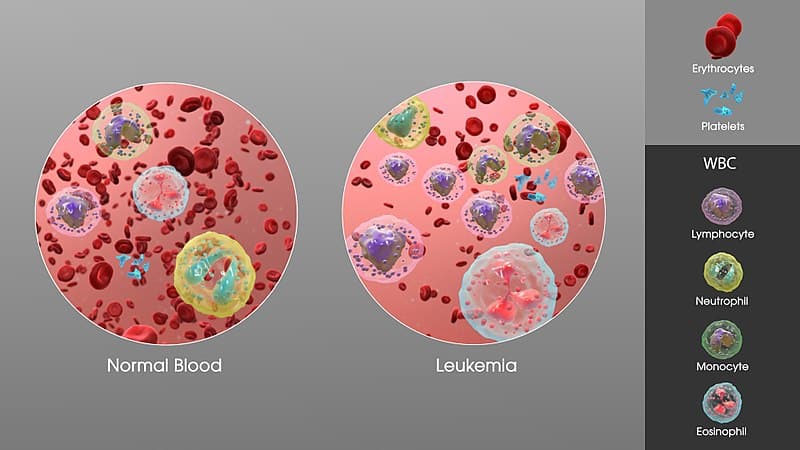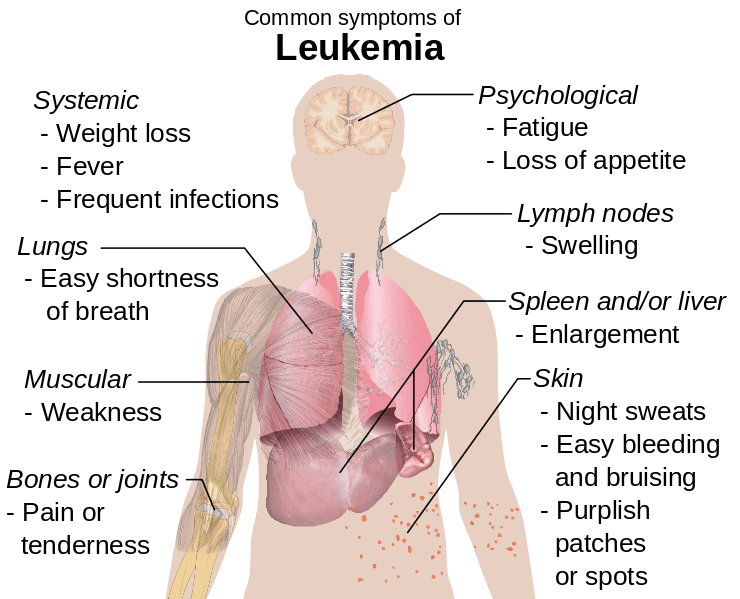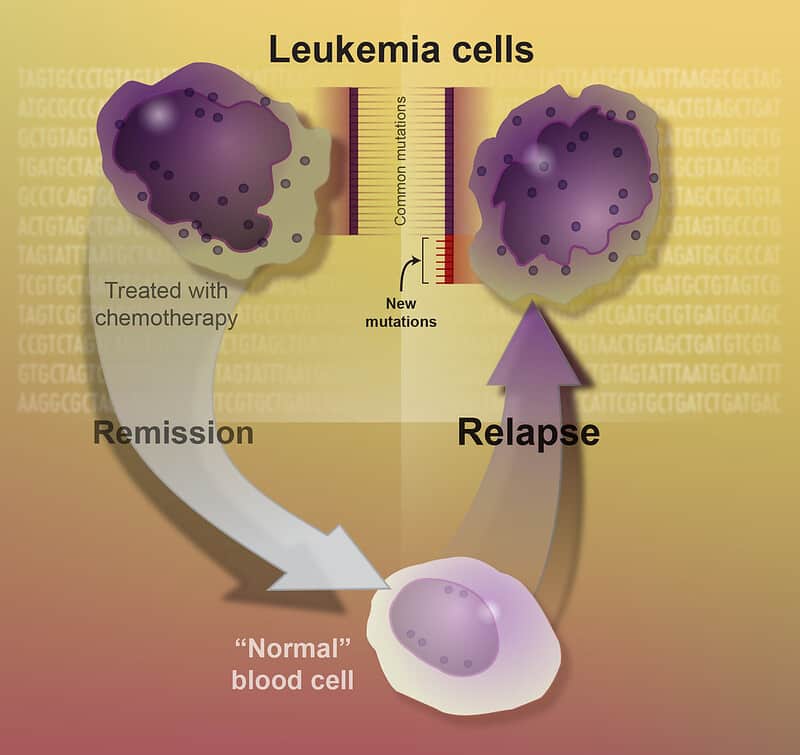Table of contents
Nebula Genomics DNA Report for Leukemia
Is leukemia genetic? We created a DNA report based on a study that attempted to answer this question. Below you can see a SAMPLE DNA report. To get your personalized DNA report, purchase our Whole Genome Sequencing!

To learn more about how Nebula Genomics reports genetic variants in the table above, check out the Nebula Research Library Tutorial.
| This information has been updated to reflect recent scientific research as of May 2021. |
What is Leukemia?
Leukemia is a group of blood cancers that usually originate in the blood and bone marrow as well as the lymphatic system. Blood cancers (leukemias) are characterized by significantly increased formation of non-functioning precursor cells of the white blood cells called leukemia cells.
White blood cells are a type of blood cell that fights infection. Unlike normal blood cells, these abnormal blood cells don’t die when they should. They may crowd out normal white blood cells, red blood cells, and platelets, making it hard for the normal cells to function.
Abnormal cells can infiltrate the liver, spleen, lymph nodes, and other organs, impairing their function. Anemia often results from a lack of oxygen-carrying red blood cells, hemostatic platelets, and mature functional white blood cells.

Depending on their course, a distinction is made between acute and chronic forms of the disease. Acute leukemias are life-threatening diseases that lead to death in a few weeks to months if left untreated. Chronic leukemias usually progress over several years and are often asymptomatic in the early stages.
There are four main types of leukemia—acute lymphoblastic leukemia (ALL), acute myelogenous leukemia (AML), chronic lymphocytic leukemia (CLL), and chronic myelogenous leukemia (CML)—as well as many less common cancers.
Is Leukemia Genetic?
Is leukemia a genetic disease? Yes. Scientists believe the various types are caused by gene mutations in the blood cells that change the way they reproduce in the bone marrow.
How is leukemia genetically inherited? While the cancer may be genetic or caused by genetic mutations, most cases are not hereditary or passed down from parent to child. In fact, it is extremely rare for it to run in families, and the chances of developing cancer are not increased if a close family member develops it.
Some genes associated with the ALL subtype are MLLT2 (chromosome 4), MYC (chromosome 8), ZNFN1A1 (chromosome 7), and LAF4 (chromosome 2). Mutations in these genes increase a person’s risk of developing the disease.
MLLT2: This gene encodes a protein that regulates RNA polymerase. It has been implicated in human childhood lymphoblastic leukemia, fragile chromosome X intellectual disability, and ataxia.
MYC: This is an oncogene that codes for transcription factors. It leads to the increased expression of many genes, including those involved in cell proliferation (a hallmark of cancer).
ZNFN1A1: This gene encodes transcription factors that belong to the family of zinc-finger DNA-binding proteins associated with chromatin remodeling. It is involved in the fetal and adult hemo-lymphopoietic system, and it functions as a regulator of lymphocyte differentiation.
LAF4: A gene that codes for transcription factors involved in lymphoid development and oncogenesis. It is exclusively expressed in lymphoid tissues.
Current Research on Genetic Leukemia
In early 2021, a study was published in the Plos One journal titled, “Enhancer polymorphisms at the IKZF1 susceptibility locus for acute lymphoblastic leukemia impact B-cell proliferation and differentiation in both Down syndrome and non-Down syndrome genetic backgrounds.”
The study aims to provide additional mechanistic evidence that connects the region encompassing IKZF1-associated polymorphisms to pro-leukemogenic effects in human cancer cell lines and mouse stem cells.
It explains that children with down syndrome have about a 10-fold increased cancer risk of developing ALL, and this risk is influenced by inherited genetic variation.
Researchers identified the region containing rs17133807 and its conserved orthologous mouse locus as having functional effects on an increased susceptibility in both the down syndrome and non-down syndrome genetic backgrounds.
There are also some studies to suggest that leukemia is not genetic. Another study, published in Environmental Health and Preventive Medicine aims to explain the relationship between the CEBPE rs2239633 polymorphism and the (CALL) susceptibility. The results suggested no significant association between the CEBPE rs2239633 polymorphism and childhood acute lymphoblastic leukemia (CALL) susceptibility.
Types of leukemia
Acute lymphoblastic leukemia (Acute lymphocytic leukemia) (ALL)
ALL is an acute form of the disease that originates from malignantly degenerated lymphocyte progenitor cells. The result is usually a rapid reduction in bone marrow function. This is accompanied by increasing general weakness and bleeding tendency.
The number of leukocytes (white blood cells) in the blood may be initially elevated, normal, or even reduced. Due to the relative lack of healthy functional leukocytes, there is also an immunodeficiency with infections that are often severe and may be life-threatening.
Treatment is by chemotherapy and sometimes radiotherapy. Today it is curable in more than 50% of adults and about 80% of children with intensive chemotherapy. The individual chances of a cure depend strongly on certain risk factors, with higher risk correlating with poorer outcomes. Generally, ALL leukemia occurs in both children and adults.
Chronic lymphocytic (CLL)
CLL is a low-malignant, leukemic B-cell non-Hodgkin lymphoma (B-NHL). It is the most common form of leukemia in the Western world and occurs primarily in older age. The median age at diagnosis is about 70 years, so the disease is sometimes colloquially referred to as geriatric leukemia.
Acute myeloid (AML)
AML is an acute form of the disease that causes bone marrow to produce abnormal myeloblasts (a type of white blood cell), red blood cells, or platelets. Acute myeloid leukemia (AML) is the most common type of acute leukemia in adults and often worsens quickly if not treated or undetected.
Chronic myeloid (CML)
CML is a chronic form of the disease associated with a severe proliferation of leukocytes (white blood cells), specifically granulocytes and their precursors, in the blood and hematopoietic bone marrow. It is often asymptomatic in the early stages.
Chronic myelomonocytic (CMML)
CMML starts in the bone marrow and spreads into healthy blood. Too many monocytes in the blood cause this type of disease. Many patients with this type have enlarged spleens, and 15 to 30% of people with CMML leukemia develop AML.
For more information on these and other types of this cancer, including treatment and support, you should visit the website of the American Cancer Society.
Epidemiology
According to the National Cancer Institute, there are an estimated 434,982 people with leukemia in the United States in 2017. Additionally, there were an estimated 61,090 new cases in 2021, with an estimated death of 23,660. Approximately 1.5 percent of men and women will be diagnosed with the disease at some point during their lifetime, based on 2015–2017 data.
NCI further revealed that between 2011 & 2017, there was 65.0% relative survival.
Although the disease is often associated with children due to the ALL form being common at young ages, the risk of leukemia increases with age. It is most frequently diagnosed in older adults from the late 60s or early 70s. It is more common in men than in women and more common in Caucasians than in African-Americans.
Signs and Symptoms
Symptoms largely depend on the type of the disease. According to Mayo Clinic, some leukemia symptoms common to all forms of leukemia include:
- Fever or chills
- Constant fatigue and weakness
- Severe or frequent infections caused by a weakened immune system
- Spontaneous weight loss
- Swollen lymph nodes, enlarged spleen or liver
- Easy bruising or bleeding
- Repeated nosebleeds
- Petechiae: tiny red spots in the skin
- Excessive sweating, especially at night
- Bone pain or discomfort

Additionally, some symptoms tend to be more common depending on the type of leukemia and whether the cancer is classified as chronic or acute.
Chronic: Chronic forms of the disease are often detected by chance through a routine examination and usually begin gradually. The first signs may be general symptoms of the disease, such as malaise and fatigue, reduced performance, fever, night sweats, and weight loss. Swelling of the spleen and lymph nodes may also occur, as well as itching, rashes, and infections.
Acute: There are a wide variety of symptoms of acute forms of the disease. Often these can arise from complete health and manifest as severe disease, e.g., pallor, weakness, bleeding tendency with spontaneous bruising or after minor trauma and petechiae occur.
Susceptibility to infection with fever, as well as swollen lymph nodes, spleen and liver enlargement, and sometimes bone pain, are also characteristic. In many cases, patients also complain of frequent nosebleeds and gingivitis. Other symptoms include loss of weight and appetite, fatigue, and night sweats.
The symptoms of ALL are caused by low numbers of normal blood cells. This effect is seen as:
- Feeling tired
- Feeling weak
- Feeling dizzy or lightheaded
- Shortness of breath
- Pale skin
- Infections that don’t go away or keep coming back
- Bruises (or small red or purple spots) on the skin
- Bleeding, such as frequent or severe nosebleeds, bleeding gums, or heavy menstrual bleeding in women
Causes
The exact cause of leukemia is unknown, but most medical professionals believe it is a combination of environmental and genetic factors. Certain lifestyle or genetic factors increase the risk of developing leukemia:
- Smoking
- Previous cancer treatment
- Exposure to certain chemicals such as benzene
- Genetic disorders such as Down Syndrome
- Family history of leukemia
- Exposure to radiations such as occurred to survivors of the atomic bomb
Diagnosis
Symptoms in early-stage leukemia appear gradually and are often undetectable. However, once a case is suspected, the doctor will typically start with a physical examination and conduct a series of other standard tests.
Physical exam
The physical exam will typically consist of a doctor checking for swollen lymph nodes, swollen or bleeding gums, a red skin rash, and signs of an enlarged spleen. They will also ask you about your symptoms, which may be non-specific such as flu-like side effects.
Complete Blood Count (CBC)
A CBC will count the types and numbers of blood cells in your body. A patient with this cancer will have higher than normal counts of white blood cells and lower than normal counts of red blood cells and platelets. Some leukemia cells may also be found
Bone marrow biopsy
If your white blood cell count is abnormal, your doctor will get a sample of cells from your bone marrow. During this procedure, a long needle is used to draw out some fluid from the marrow of your bone, usually from an area near your hip (pelvic bone). This test helps determine the percentage of abnormal cells in the bone marrow, which confirms leukemia diagnosis.
Treatment Options
In most cases, treatment for leukemia involves chemotherapy, especially in cases of childhood leukemia. However, other types of treatment are available based on the severity and course of the disease when diagnosed.
Chemotherapy: This is the most common treatment. The chemicals in this treatment are used to kill leukemia cells that are blocking normal blood cells. Chemotherapy can be administered as either a pill or an injection.
It’s important to remember that chemotherapy may not kill all of the cancerous cells. Some surviving cells may create new mutations, leading to cancerous relapse.

Targeted therapy: These are special drugs that are designed to target and kill cancer cells. Your doctor will tell you if the presentation of the disease may be more susceptible to this type of therapy.
Radiation therapy: Radiation therapy uses X-rays or other high-energy beams to damage the cancer cells and stop their growth. Sometimes radiation is conducted at a specific part of the body to target large collections of abnormal cells.
Bone marrow transplant: This surgical procedure, also called a stem cell transplant, replaces abnormal bone marrow with healthy stem cells that will grow and divide to form normal bone marrow cells. The resulting marrow should then produce healthy blood cells. Before this procedure, patients typically receive high doses of chemotherapy or radiation therapy to kill any remaining leukemia-producing bone marrow.
Community support can be a huge benefit to patients undergoing cancer treatment. The Leukemia & Lymphoma Society offers everything from peer-to-peer support groups, accessible health information, consultations with healthcare professionals, and financial support.
Clinical trials based on cancer research are supported by many large foundations and health care institutes, including the National Cancer Society. Some patients may benefit from these experimental drugs when other forms of treatment have failed.
If you liked this article, you should check out our other posts in the Nebula Research Library!
You may be particularly interested in other forms of the disease, such as CLL and thyroid cancer.
July 12, 2022
